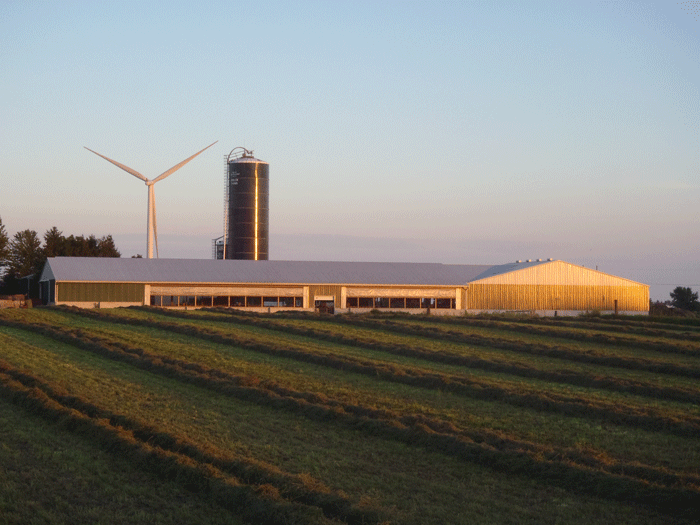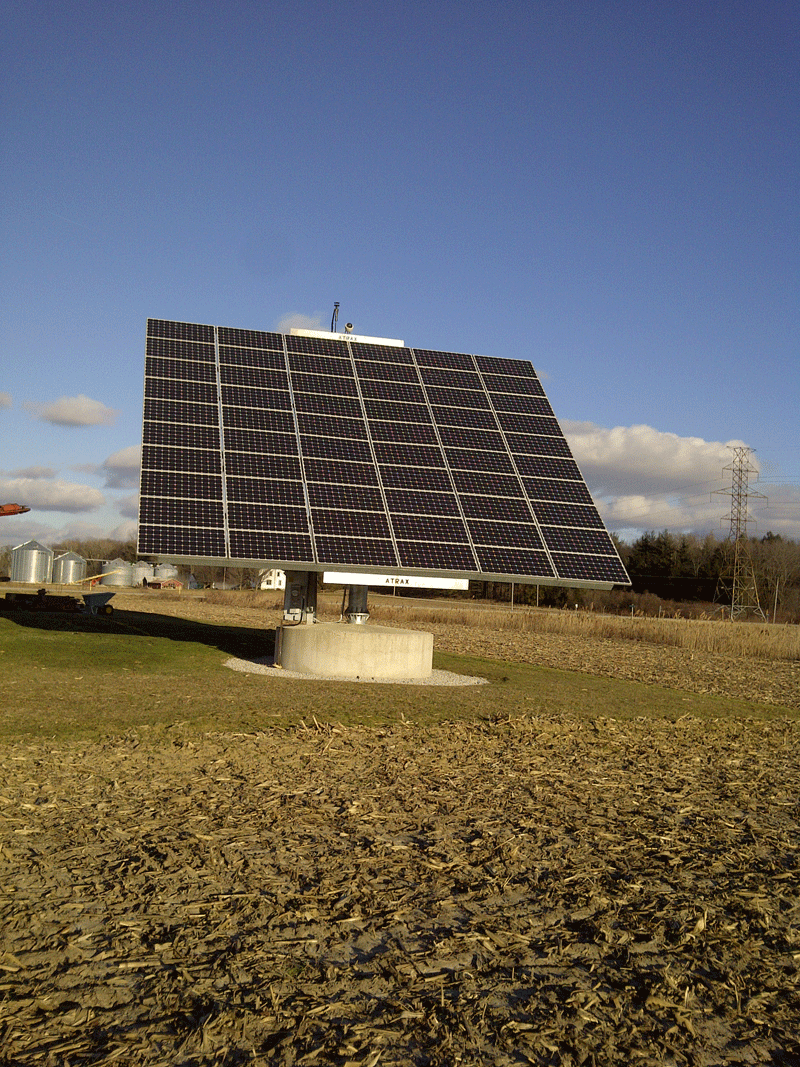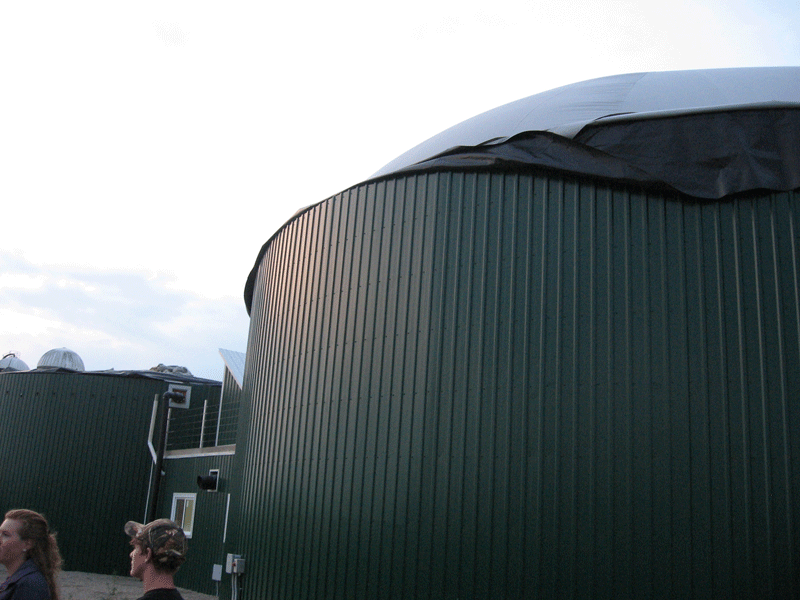Green energy
A LOOK AT WIND, SOLAR AND BIODIGESTERS ON THE FARM
Many farmers are seeing the need to diversify their operations in order to stay viable; and some of them are turning to green energy as an additional source of income or as a means to reduce operating costs. Wind turbines, solar panels and biodigesters are gaining in popularity despite the controversy some of these alternative forms of power generate. We take a look at three Ontario farms that have made the decision to incorporate a green energy source on their farm.
a snapshot of wind Energy in ontario
Ontario farmers and rural landowners are increasing their commitment to green energy. The industry has seen significant growth in recent years and wind turbines are currently generating three percent of Ontario’s total electricity needs. By the end of 2012, Ontario had installed more than 2,000 megawatts (MW) of wind power capacity – compared to 400 MW in 2006 – and if all projects move forward, an additional 400 MW of capacity could be added by the end of 2013.

Brandy Giannetta, Ontario regional director for the Canadian Wind Energy Association (CanWEA) says the Ontario Power Authority projects 10 percent of Ontario’s electricity needs will be powered by renewable energy by 2015 through a combination of wind, solar and biomass. Nationally, CanWEA aims to meet 20 per cent of Canada’s total electricity demand with wind power by 2025. These may appear lofty objectives, but Giannetta points out that in 2012 alone, wind energy surpassed coal energy outputs.
Ontario is currently home to 46 wind farms with 1,103 turbines in total. Eastern Ontario, southwestern Ontario (Chatham-Kent) and the Niagara region are areas currently seeing the most wind turbine development in the province. “Many farmers and landowners are willing partners looking to contribute and generate a clean and green energy source,” says Giannetta. “They are also attracted to wind energy because it can provide an additional source of income, create jobs and offers financial investments within their communities.”
winning with wind
For Rudy Zubler, the blades of a wind turbine turning, generating energy from his farmland has been a dream come true. Concerned with the sustainability of our species on this planet and his own ecological footprint, Zubler is proud to be part of the Talbot Wind Farm, located in Chatham-Kent, Ontario.
The wind farm is like a power plant comprised of multiple wind turbines. Zubler’s turbine is one of 43 making up the Talbot Wind Farm originally built and operated by Renewable Energy Systems Canada, now owned by Enbridge. The wind farm generates approximately 98.9 MW of power, producing enough clean, renewable electricity to power approximately 33,000 typical Canadian homes per year.
Power generated by the turbine on Zubler’s farm enters the Ontario transmission network, and flows to customers across southern Ontario. Over a 20-year life span of the facility, the Talbot Wind Farm is projected to benefit the local economy by $26 million.
Zubler and his wife, Barbara, own and operate an organic dairy farm in Ridgetown, Ontario, milking 90 cows and working 170 acres of land in a rotation of organic wheat, corn, soybeans, forage and forage grains. They also farm with his brother and father on a neighbouring conventional cash crop farm and custom work enterprise. “I’ve always been interested in resource conservation and efficiencies,” he says, making the decision to become part of a sustainable energy system and build a wind turbine on his farm an easy one. But for Zubler, it was the information gathering and negotiation process that created headaches in developing the turbine.
When wind energy companies began approaching Zubler and his neighbours, it made sense to have a neighbourhood meeting to discuss the matter. What began as an informal discussion of roughly 25 neighbours, turned into a strong negotiating group of farmers. “I would never put up a turbine without my neighbours cooperation,” says Zubler. “Together we decided which company to work with, helped each other learn more about the pros and cons and negotiated the best possible rates at the time.”
With neighbourhood support, the project received a green light. Four years after the first meetings, Zubler watched the turbine turn for the first time in December 2010. Now in its second full year of operation, Zubler is still happy with his decision. The remuneration per wind turbine tower and returns from land negotiated in the contract certainly help Zubler sleep easier at night, in fact, he says he hasn’t had any problems with the towers at all. The turbine on his farm is set back 650 metres from his farm house and buildings, exceeding the minimum setback of 550 metres as determined by the provincial government. “The turbines have had a positive impact overall, both to our farming operation and to the local municipality,” says Zubler. “They’ve added to the landscape and the sustainability of our community.”
Communication has been an important part of the process, says Zubler. The neighbours had open and transparent communication in the decisions and negotiations associated with the development of the wind farm and Zubler believes the company itself has been very good about communicating with the landowners. Enbridge hosts annual landowner meetings to discuss issues or concerns as part of their community relations outreach.
Zubler firmly believes communication is key to the development of turbines and alternative energy sources and advises other farmers who find themselves considering becoming part of a wind farm, or building their own turbine to talk to their neighbours. And, when it comes to signing agreements, he says “make sure you know what you are getting into.”
ontario couple harvests the sun
When most farmers think of retirement income, selling the farm or succession often come to mind; but not to Ken and Sue McLarty. They approached eco-power and on-farm solar energy generation as an opportunity to diversify their farm operation and generate an income stream during retirement. The couple already have a ground-mount solar panel on their Ridgetown, Ontario farm and are in the process of working with Agris Solar Co-operative to install two additional panels as part of the co-op’s solar garden.

The McLarty’s aren’t alone in their interest in on-farm solar power generation. The Ontario Power Authority (OPA) reported that as of early January, 9,373 applications – representing 86,909.9 MW of power – were received for solar photovoltaic (PV) systems under Version 2 of the microFIT Program. The microFIT Program is a streamlined program for small renewable energy projects under the umbrella of Ontario’s Feed-in Tariff (FIT) Program. Developed for renewable electricity generation projects of 10 kilowatts (kW) or less, the microFIT program was launched in 2009 as part of the Ontario government’s efforts to increase renewable energy in the province. The program pays a guaranteed price over a 20-year term for all electricity produced and delivered to the province’s electricity grid. Of the projects submitted, 5,057 were unsuccessful, 547 are currently under review, and 3,779 have been executed, meaning they range from the early stages of development to fully connected to the grid.
“The popularity of establishing on-farm solar panels seems to have peaked, but still continues in a slower form,” says Don Hilborn, an engineer in the Environmental Management Branch of the Ontario Ministry of Agriculture, Food and Rural Affairs (OMAFRA). Hilborn notes the process has changed significantly from earlier versions of the microFIT program.
The McLarty’s operate a 500 acre cash crop farm rotating corn, soybeans and wheat. They built their ground-mount panel during the summer of 2010 and it was hooked up to the grid in September of the same year. They say the rules and regulations have certainly changed since they first embarked on the process. Ground-mounted systems were popular in the beginning of the microFIT program since they could achieve higher yields and the price owners would receive for the electricity was high enough to offset the additional capital cost of the system. Now, there are more rooftop systems being developed says Hilborn, noting the microFIT prices are higher for roof-mount systems.
Both Hilborn and the McLarty’s urge farmers and landowners considering solar panels to do their homework. “Investigate opportunities and make sure you do your research before signing up,” says Ken McLarty who consulted neighbours and local farm leaders, spoke with suppliers and attended information sessions on solar energy hosted by OMAFRA and the University of Guelph before making the decision to invest in the development of their solar unit.
“There are a lot of steps and a lot of rules unique to the microFIT and FIT connections,” says Hilborn who reminds growers there is a lot to consider in the development of the panels. He notes that several things, including Ontario’s climate, can affect solar panels, “hot and cold temperatures, along with high winds can impact the productivity, not to mention ongoing and necessary maintenance and repairs.”
“Solar systems will degrade slightly over time which will reduce yield,” says Hilborn who notes that since the technology is still relatively new, no one has a good understanding of the long term cost of upkeep on things like system maintenance and insurance. FIT prices were set to support a return on equity of 11 percent, working out to a simple payback of nine years. Hilborn notes many well operating systems may currently be projecting a faster payback, however, since panel owners are only in year two or three of its planned 20 years of operation it’s too early to predict the final result.
Hilborn also reminds farmers and landowners who have solar panels or are considering them, that the systems need ongoing monitoring and maintenance. “Systems can shut off for some reason or another and you could be missing the income for a period of time,” he warns, saying systems can also have some lowering of yield due to a number of factors including panel age, panel damage, need for panel cleaning, connection issues and inverter problems. In addition, weather safety systems such as wind sensors that cause a tracker system to flatten under high wind conditions must be working. It’s good practice to check systems before and during the early stages of an expected high wind to verify they are functioning properly.
Not all farmers and landowners installing solar panels sell the generated electricity back to the grid, or the OPA. There are a number of Ontario farms currently using solar energy for unique uses like fencers, remote water pumps, gate controls and lights. Hilborn says that as the price of purchased energy goes up and the price of solar systems goes down, he expects more interest in net metering. Overall, solar panels are providing an alternative energy source while offering farmers and rural landowners, like the McLarty’s, another income generating option and the chance to increase the sustainability of our environment.
making money from manure
Korb Whale of Clovermead Farms says his dad believes a farmer should buy land based on how much manure the farm produces. Today, Whale is the seventh generation to operate the family farm in partnership with his parents, and he’s added his own spin on the land-based philosophy. Whale has been working to close the loop on the sustainability of the family’s farm by developing an on-farm anaerobic biodigester.

“We had enough land to feed the cows and enough manure to fertilize the land, now we utilize our manure to feed the digester too,” says Whale. The family’s 150 cow dairy farm, located in Alma, Ontario, operates 475 acres, with almost half the land in corn production. With a civil engineering background, Whale always knew he wanted to make the most of everything produced on the farm – including manure.
He started out seven years ago, looking at the feasibility of generating natural gas from an on-farm biodigester. Similar projects were very successful in California, but Whale soon learned it would be too costly to install a pipeline to sell the gas. His next idea was an anaerobic biodigester that would convert manure into electricity that could be sold back to the grid. It was easier said than done, admits Whale, but he’s proud to say his idea is now a reality and the digester has been supplying electricity to the OPA since October, 2012.
Generating 250 kW of continuous electrical capacity, the digester is based on a Danish design of two tanks, each with a holding capacity of one million litres of manure. Anaerobic digestion is a series of processes in which microorganisms break down biodegradable material in the absence of oxygen. This process produces biogas – consisting primarily of methane and carbon dioxide – and is often referred to as a “biogas system.”
Whale compares the function of a digester to a cow’s stomach saying, “ there are different phases and compartments that all work to produce an end product.” Anaerobic digestion is made up of four key biological and chemical stages – hydrolysis, acidogenesis, acetogenisis and methanogensis.
The Whale’s dairy barn is scraped six times a day, and the manure is fed into a batch mixing tank where it is blended with additional materials to create the ideal “food” mixture for the digester. Everything is preheated using water in coil loops so the temperature of the manure mixture doesn’t shock the bugs in the digester. The mixture is also heated for pasteurization to eliminate unwanted organisms that can affect the digestion process. The biogas produced from the process is combusted, resulting in renewable electricity. After the digestion, the solids are separated from the liquids.
Whale estimates he spends 15 hours a week in labour to operate and maintain the digester. In addition to regular maintenance and adding manure to the system daily, the digester is constantly tested and analyzed for pH levels, temperature and gas quality.
Whale says the biggest hurdle in the development of the on-farm system was hooking up to the grid. In order to sell the electricity back to the OPA, Whale was required to upgrade a portion of hydro lines at his own expense.
Jake DeBruyn, Engineer for New Technology Integration with OMAFRA says Whale isn’t alone. “One of the first things to look into is the ability to connect to the electrical grid and the potential need to upgrade electrical infrastructure – that can be a key factor in whether a project is viable.”
Ontario’s older electrical infrastructure isn’t designed for distributed electrical generation, and currently, farmers find themselves in the position of paying for most of the upgrades where necessary. DeBruyn also notes financing as a limiting factor, particularly for non-dairy facilities since financial institutions are still cautious about this new technology.
The average on-farm digester costs approximately $2 million dollars to build, but can provide $350,000 per year in electricity revenue and $50,000 per year in tipping fees from food waste (digesters can utilize food waste that would otherwise be disposed of).
Whale estimates his system generates $1,000 of electricity per day and aims to have his system paid off within eight to ten years. With operating and financing costs accounted for, digesters are expected to return the same rate as a solar PV project, approximately 11 percent, based on the current FIT program.
“Farmers are often intrigued by this new technology because it can offer an additional revenue stream, provides an alternative way to clean up manure and can be an interesting opportunity for the next generation,” says DeBruyn. For those farmers interested in learning more about digesters, he encourages them to visit facilities that are already in operation and check out industry information sources such as the Biogas Association, the Canadian Biogas Conference in London, Ontario at the beginning of March and the OMAFRA website.
Whale is confident in his green energy investment, and while it’s been a long journey from his initial idea of converting manure into natural gas, he has learned a lot along the way. He says he’ll be even happier when he receives his first pay cheque from the OPA for the electricity he’s been generating since last fall. Despite the challenges he has encountered and those that still exist, Whale believes that by locking in his electricity prices by generating power through the digester today, he is positioning himself to be even more competitive on the global market tomorrow. •






















